5. Short-term memory
1/48
There's no tags or description
Looks like no tags are added yet.
Name | Mastery | Learn | Test | Matching | Spaced |
|---|
No study sessions yet.
49 Terms
Memory ovreview
Sensory Stores
Visual Sensory Memory/Iconic Memory
Auditory Sensory Memory/Echoic Memory
Short-Term Memory
Holds information for up to 30 seconds
Limited in Capacity
Long-Term Memory
Holds information for long periods of time
Unlimited capacity
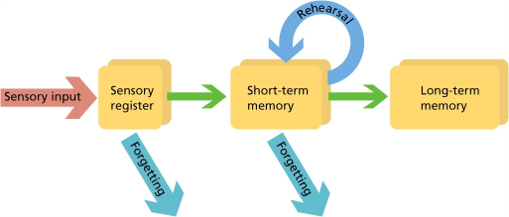
Short-term memory
_________________ - The capacity to hold a small amount of information in mind in an active, readily available state for a short period of time
STM often refers to the input and storage of new information
embodies the notion of a limited-capacity system
Aspects of STM
STM
_______________ - Three types:
Where the immediately present moment is held in consciousness
Where active mental effort is expended
Where comprehension takes place
Synonyms for STM
STM
_______________ - lots of definitions:
Working memory
Short-term store
Primary Memory
Elementary memory; intermediate memory; temporary memory
STM vs. Working Memory
_______________
STM
Older
Input and storage of new information
E.g., remembering a phone number
Working Memory
Newer
Processing and storage
The mental workbench
E.g., Understanding a sentence

Bottleneck
STM
______________ - LOTS of info, but only some gets in
STM cannot encode and hold vast amounts of new info
E.g., Recall as many of these letters as you can in the order in which they appeared
Miller’s Magical Number Seven, Plus or Minus Two
Cowan, 2010: 3-5 Chunks

Chunking
STM - Bottleneck (overcoming it)
_____________ - grouping information into richer, more complex items or units called chunks

Recoding
STM - Bottleneck (overcoming it)
____________ - the process of grouping items together and then remembering the newly formed groups
Two conditions:
Time/Resources;
Well-learned

Mnemonic devices
STM - Bottleneck (overcoming it)
________________ - Any mental device or strategy that provides a useful rehearsal strategy for storing and remembering material
E.g., Method of Loci
The Brown-Peterson Task
________________ - How long does non-rehearsed information stay in STM? — says basically, performance gets worse
On each trial, the subject sees three letters, followed by three numbers
e.g., PIR-393.
Subjects must remember the letters while counting backwards by 3s from the number.
Plot recall accuracy by time spent counting.
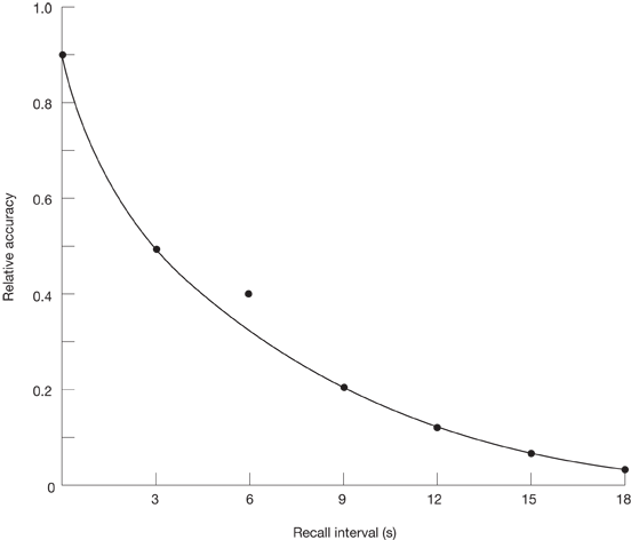
Decay
Brown-Peterson Task → Interpretation
______________ (or fading) - Loss of a memory trace due simply to the passage of time
Interference
Brown-Peterson Task → Interpretation
______________ - is the loss of a memory trace due to competition from other stimuli or events
Decay hypothesis
Brown-Peterson Task → Challenges → Waugh and Norman’s (1965) predictions
________________ - If forgetting was caused by decay, then the 16 second group (1 word/second) would have lower recall accuracy.
i.e. 16 second group would forget more
Waugh and Norman
Brown-Peterson Task → Challenges
___________________ (1965) - Participants heard a list of 16 digits read at either 1 or 4 digits per second.
Last digit was a repeat of an earlier one. Participant had to remember which digit came after it.
E.g., 7, 4, 6, 9… 4 → remember 6
Key: presentation time of the lists
Interference hypothesis
Brown-Peterson Task → Challenges → Waugh and Norman’s (1965) predictions
________________ - If forgetting was caused by interference the two groups should be similar.
Waugh and Norman RESULTS
Brown-Peterson Task → Challenges → Waugh and Norman (1965)
_____________ - demonstrated that forgetting in short-term memory is primarily due to interference from new information, rather than simply the passage of time.

Proactive interference (PI)
________________ - when older material interferes forward in time with your recollection of the current stimulus
Previously presented material interferes with new learning
Previous ruins ongoing
Retroactive interference (RI)
______________ - newer material interferes backward in time with your recollection of older items
Recent material interferes with older learning
Recent effects that ruin old
E.g., Learning material towards the end of a course can interfere with your ability to remember material from earlier in the course.

Release from PI
Brown-Peterson Task
______________ (RPI) - a phenomenon where recall improves when the semantic category of items to be remembered is changed
Wickens (1972)
Dog, Cat, Mouse – 745
Rabbit, Horse, Tiger – 687
Zebra, Giraffe, Elephant – 496
Doctor, Lawyer, Baker – 891

Short-term memory retrieval
STM
_______________ - Bringing knowledge to the foreground of thinking
Allows us to manipulate or report the information
Types of Recall: Free recall and serial recall
Free recall
Short-term memory retrieval → Types of recall
__________________ - recall the items in any order
Ex: Grocery list
Serial recall
Short-term memory retrieval → Types of recall
______________ - recall items in exact order in which they were presented
Ex: Phone number
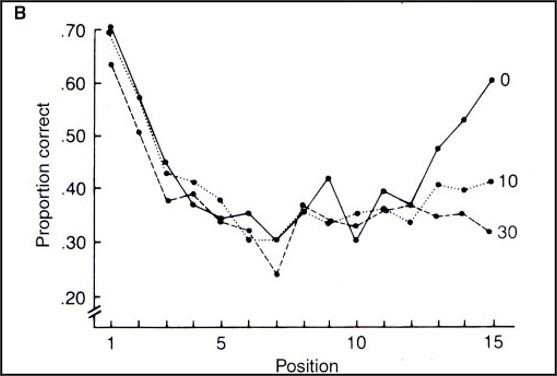
Primacy effects
Short-term memory retrieval → Types of recall → Serial position curve explanations
________________ - Better memory for items in the early positions of the list— Long-term memory effect
First items in a list get the best and most rehearsal
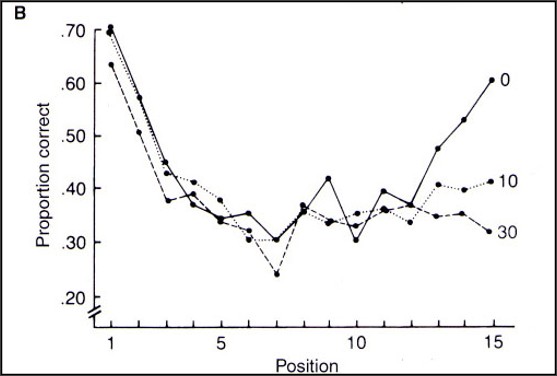
Recency effects
Short-term memory retrieval → Types of recall → Serial position curve explanations
__________________- Better memory for items at the end positions of the list— Short-term memory effect
Last items in the list are still in STM at the time of recall
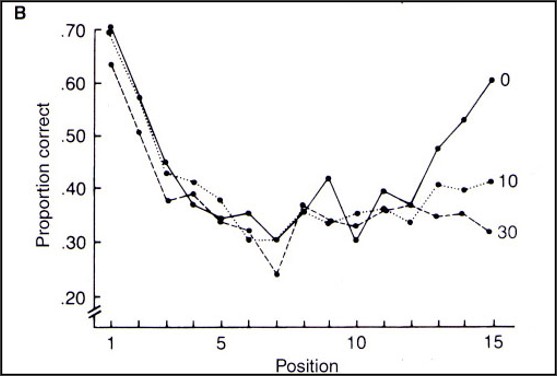
Evidence for the Standard explanation
Short-term memory retrieval → Types of recall → Serial position curve explanations
________________ - Interference task wipes out the recency effect, but not the primacy effect
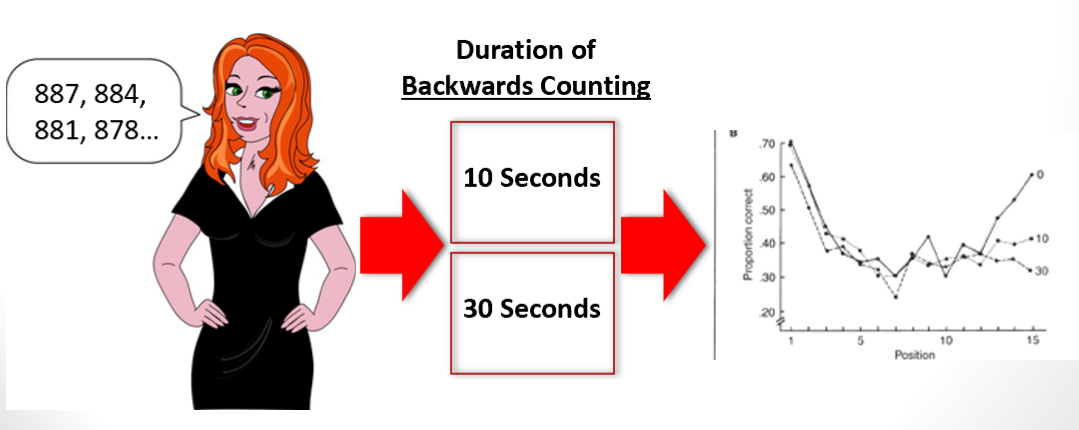
Rehearsal
______________ - Keeps information in STM— Refresh in the mind
Increases the probability that information will be transferred to long-term memory
Models of STM and Working Memory
_______________ - How is memory conceptualized?
How do researchers think it works?
Multi-Store Models and Unitary Models
Multi-store models
Atkinson and Shiffrin
Baddeley’s Working Memory Model
Unitary-Store Models
-No STM/LTM distinction
Multi-store models
Models of STM and Working Memory
________________ - models of memory that have multiple components for how memory works
E.g., Atkinson and Shiffrin Modal Model

Overview of working memory
Working memory
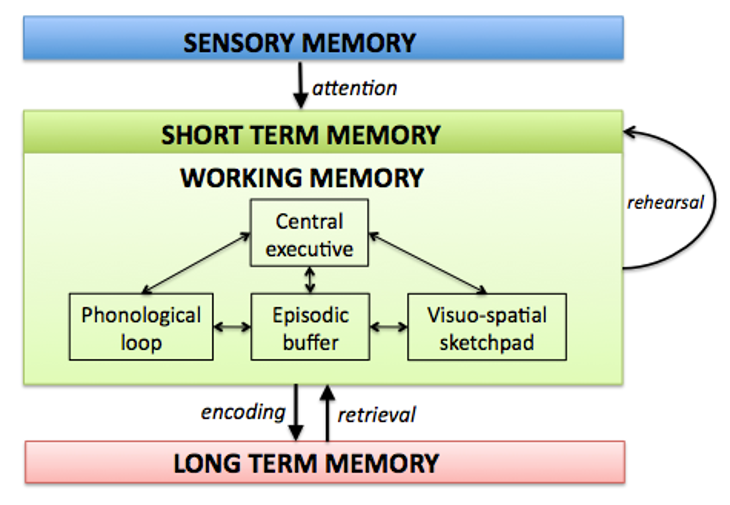
Central executive
Components of working memory
___________ - In charge of planning future actions, initiating retrieval and decision processes as necessary, and integrating information coming into the system
Monitors and coordinates subsystems
I.e., Visuo-Spatial Sketch Pad and Phonological Loop
Has its own pool of resources
For use preforming tasks (e.g., comprehension)
E.g., “I know that you are not unaware of my inability to speak German”
Can supply subsystems
1) Visuo-spatial sketchpad (VSSP)
Components of working memory
___________ - One of two subsystems in WM— A system specialized for visual and spatial information
Displays and manipulates information
E.g., Is the doorknob for your bedroom door on the left or right side?
May be used in spatial awareness
Mental rotation
Components of working memory → VSSP
___________ - Mentally turning, spinning or rotating objects in the VSSP of working memory

Boundary extension
Components of working memory → VSSP
_______________ - People tend to misremember more of a scene than was actually viewed, as if the boundaries of an image were extended further out
Ex: Anticipates active movement in the environment– your mind knows there is MORE to a scene than just what is shown in a picture or movie
Representational momentum
Components of working memory → VSSP
_______________ - the phenomenon of misremembering the movement of an object further along its path of travel than where it actually was when it was last seen
2) Phonological loop
Components of working memory
_______________ - Second subsystem in WM —The speech- and sound-related component responsible for rehearsal of verbal information and phonological processing
Recycles information for immediate recall
Two components:
Phonological Store
Articulatory loop
Episodic buffer
Components of working memory
_______________ - The portion of working memory where information from different modalities and sources is bound together to form new episodic memories
Phonological store
Components of working memory → phonological loop
_______________ - ½ components of phonological loop— passive store; “inner ear”
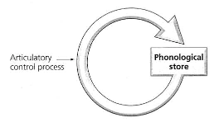
Articulatory loop
Components of working memory → phonological loop
_______________ - 2/2 components of phonological loop— active refreshing of information in the phonological store; “inner voice”
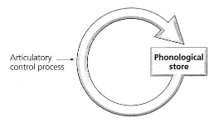
Articulatory suppression effect
Components of working memory → phonological loop
____________ - the finding that people have poorer memory for a set of words if they are asked to say something while trying to remember the words
Phonological similarity effect
Components of working memory → phonological loop
____________ - The finding that memory is poorer when people need to remember a set of words that are phonologically similar, compared to a set of words that are phonologically dissimilar
Dual task method
Studying working memory
_________________ - Two tasks are done simultaneously.
Can they be done independently or do they interfere with one another?
Brooks (1968) → provided evidence that mentally scanning an imagined object and scanning a real object involve similar spatial processes
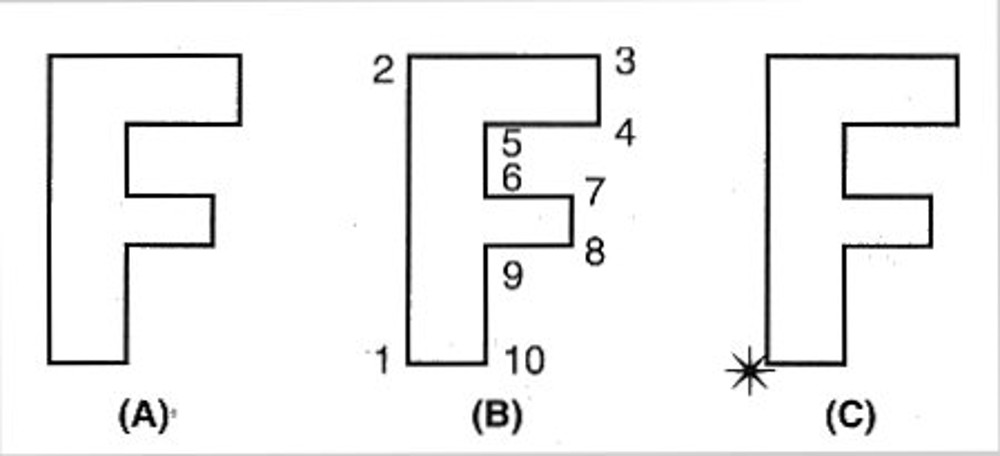
Support for WM
_______________ - Supported by some neurological evidence:
WM backed by localization of function & systems in the brain
E.g., Occipital and parietal lobes are activated with VSSP working memory tasks
E.g., Temporal lobes and language areas are activated in phonological loop tasks
Dual Task Research: Indicates that VSSP and PL are distinct systems
E.g., Brooks (1968)
Dissociation Evidence: Short-term store is compromised, but no major deficits in learning, memory, or comprehension
Problems w/ WM
________________ -
Central Executive: Vague concept; catch-all
“Little person in the head”
Episodic Buffer: Vaguely specified, not in original model
Limited Description of Modalities:
Only two are included; what about the others?
Dissociations: Further neurological evidence indicates that there are dissociations within the subsystems
Unitary-store models of memory
Models of STM and Working Memory
______________ - One store of memory— no short-term/long-term distinction
One set of representations that comprise our knowledge store
I.e., short-term memory is long-term memory that has recently been activated beyond a threshold
Attentional focus can be directed to activated representations
Rehearsal strengthens representations
Reevaluation of dissociations
Locating WM
______________ - a term for the set of mental operations, not a specific place in the brain.
Reflects the currently activated portion of LTM
We have a system called working memory, but its not that its located in one specific location but is all over the place
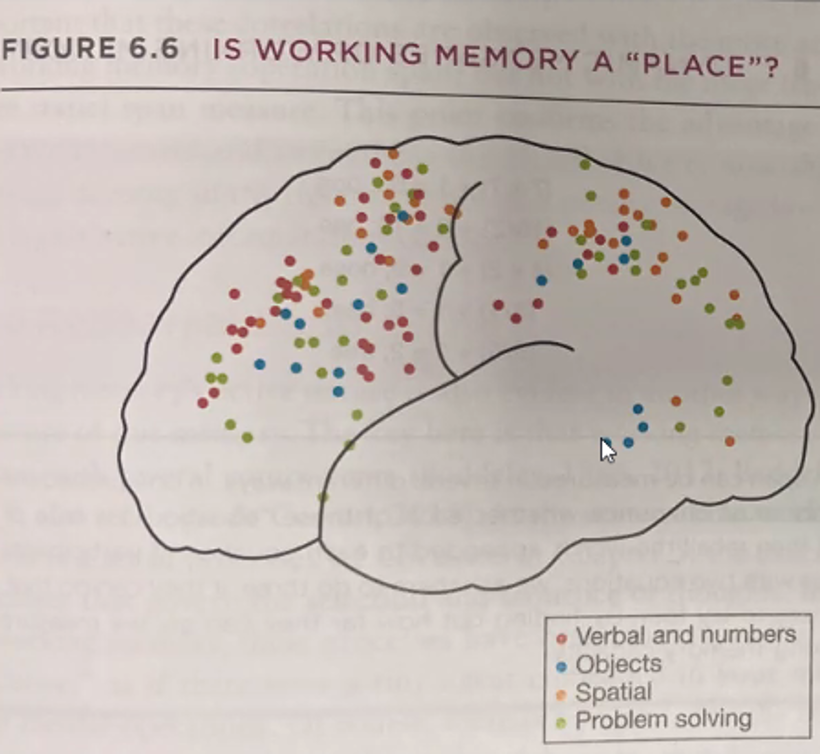
Digit span task
Measuring WM span
______________ - Participants are exposed to a set of digits they must repeat back
If successful, they get a longer list, then another…
Operation span
Measuring WM span
_____________ - Different types of tasks for different “operations”
More dynamic measures of WM
Ex: Reading span task, arithmetic task
These tasks can be used to investigate individual differences— A bigger operation span is typically advantageous
Correlates with other faculties
Reading comprehension
Standardized academic tests (SAT)
Attention
Reasoning abilities
General intelligence
…Not the whole story for cognition
Reading span task
Measuring WM span → operation span examples
______________ - Requires the participant to read while holding information in WM
Participant reads two sentences, and has to repeat the last word in each
If successful, they get three sentences, then four…
Example:
Based on his prior experience, he was hired for the vacant managerial position. (have to remember position)
He believes the cookies were stolen by a rogue child. (have to remember child)
Arithmetic task
Measuring WM span → operation span examples
______________ - People see equations and read them out loud, then indicate if the answer is correct and say the word
They do the same for the next equation and then, at some point, must report all of the words
Example:
(6x2) – 2 = 10? SPOT
(5x3) -2 = 12? TRAIL
(10/2) + 6 = 10? GAS